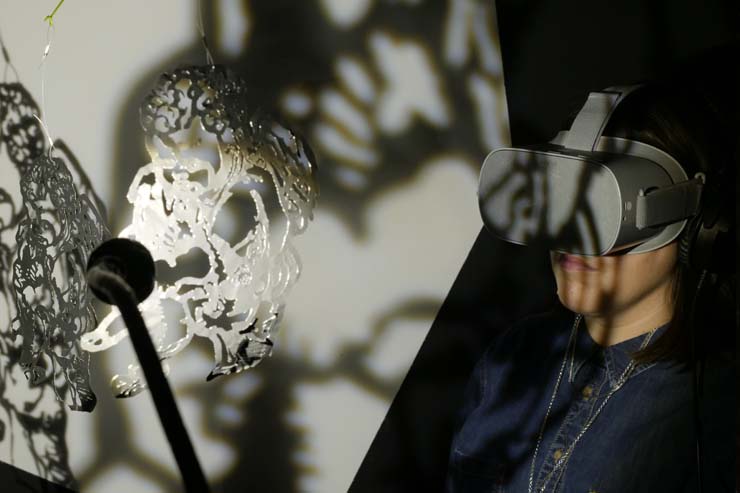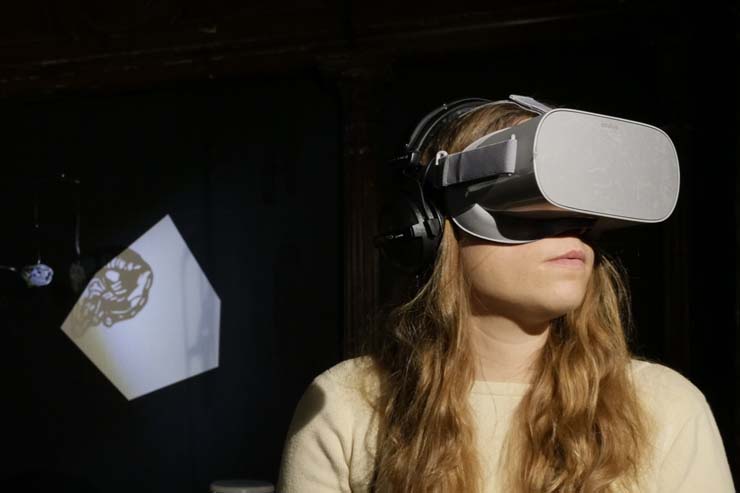As two attendants prepare us to experience Care(less), a new virtual reality installation by Lindsay Seers at Fabrica, we can’t deny a flutter of nerves. We have no idea, literally none, of what to expect. One of them invites us to strap on a data pack like a rucksack, while another adjusts a set of VR goggles which cuts out our vision. “If you need to stop for any reason just raise your hand,” counsels one of the attendants kindly. A hefty pair of headphones muffles all sound from the room and then we are gone, into another world.
Seers is an internationally renowned video artist, with work in the permanent collection at the Tate but, truth to tell, we’ve come here today as blank canvases with no knowledge of her past work or its themes, and precious little experience of virtual reality. Seers too, it seems, is breaking new ground with this, her very first foray into VR. She is here today nervously pacing as we, a select handful of volunteers, experience her new artwork for the very first time before her show opens tomorrow. It’s a solemn and rather moving moment.

Fabrica has been partitioned off to create a small, intimate and dimly lit inner sanctum, in which a handful of chairs are positioned. We experience the artwork sitting down, but we can swivel our chairs to look all the way around us as the piece unfolds. This is a non-narrative work, so there can’t be ‘spoilers’ as such, but we’ll keep our descriptions of the piece itself vague so viewers can experience it as we did – afresh and without prejudice. It is a free-flowing journey of fixed duration, lasting about fifteen minutes, which contains moments of relative abstraction, together with sudden, at times jolting, moments of realism, like awakening from a fever dream. The perspectives shift and encourage us to suddenly look up, look down, or turn sideways. We are guided by two separate narrating voices that offer some context to the ever-changing tapestry of floating images.
Care(less) was commissioned in part by the Wellcome Trust, and continues an ongoing programme at Fabrica to commission artwork which confronts themes of death and dying (their 2017 installation on hospices, The Interval And The Instant, was an all time favourite of ours). The subject of caring for the elderly is a pretty hot topic at the moment, with debates raging as to how this system is valued, or undervalued, in our society. The exhibition was originally inspired by research at the University of Brighton examining the experiences of people in care, many of whom pay for it out of their own life savings – and the installation seeks to simulate aspects of helplessness, loss of bodily control, changes in consciousness and thoughts on imminent death. It is emphatically not a lecture on any of the rights or wrongs of this situation (though clearly it advocates for new and kinder ways of looking at things). Rather like a poem it instead gives, in quite an abstract sense, a flavour of the human experience behind the debates, and sets the stage for subsequent thought, discussion and, ultimately, empathy.

We manage to sit down with the artist for a few minutes after watching the piece. Lindsay Seers is a very impressive character, with a gentle purposeful manner and an underlying kindness which, we can be sure, informed this artwork. It was, she explains, created during four months of very intense work, and inspired in part by the death of her own father who seemed to experience hallucinations and varying mind-states during his final illness. Virtual reality, which literally sends different sensory information to the brain, can influence consciousness, and induce sudden feelings of trepidation, vertigo or differences in perceptions of scale. As such it seems uniquely suited to Seers’ own desire to emulate the experiences of an elderly person like her dad. “Consciousness isn’t singular,” she explains. “It can be very fragmentary – constantly becoming and adjusting.”
This is a bold exhibition. For any technophobes out there who struggle with the basics in Photoshop, it’s a technical tour-de-force from Seers just in the sheer mind-boggling skills required to make it work, a veritable Faberge egg of digital programming. Fabrica are brave to mount such a technically challenging show – their attendants will, we suppose, be rushed off their feet setting up all those headsets and headphones. Our only slight worry is that, with just a handful of seats, this display may get very crowded at peak times. Our advice: visit on a weekday if you can, and be prepared to possibly queue a short while. It’s worth it.
Check the Fabrica website for a programme of related events, including an artist talk from Lindsay Seers on November 2nd.
Care(less), Fabrica, 5th October – 24th November 2019
www.fabrica.org.uk
Photographs by Tom Thistlethwaite

